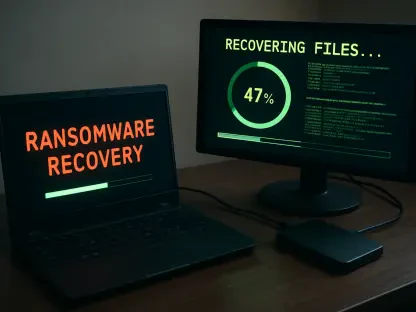In a quiet digital ambush, a group of Russian agricultural firms found themselves under siege just days before a major industry forum in Moscow, highlighting the growing threat of cyber espionage. Disguised as an official event program, phishing emails delivered a malicious payload that compromised critical systems with alarming precision. This attack, attributed to the state-sponsored threat actor Cloud Atlas, underscores a chilling reality: cyber espionage is no longer a distant threat but a pervasive danger targeting vital sectors. With agriculture and defense industries increasingly in the crosshairs, particularly in geopolitically tense regions, the sophistication and stealth of groups like Cloud Atlas demand urgent attention. This analysis delves into their evolving tactics, the broader trends in state-sponsored cyber threats, and the critical implications for global cybersecurity.
Unpacking Cloud Atlas: A Persistent Cyber Threat
Evolution and Scale of Cloud Atlas Campaigns
Cloud Atlas has been a formidable player in the cyber espionage landscape since at least 2014, focusing on data theft and surveillance across a range of countries including Russia, Belarus, Azerbaijan, Turkey, and Slovenia. Their operations have spanned diverse geopolitical arenas, targeting entities with strategic significance. The group’s ability to sustain long-term campaigns highlights a calculated approach to espionage, often aligning with broader national interests that remain obscured by anonymity.
Recent data from F6, a Russia-based cybersecurity firm, indicates a marked uptick in Cloud Atlas’s activity over the past year, with a pronounced focus on Russian and Belarusian entities. This surge, observed in 2025, suggests an intensification of efforts to penetrate key infrastructures. The group’s persistent targeting of specific regions points to a deliberate strategy, likely driven by geopolitical undercurrents that shape their selection of victims.
A notable trend is the group’s focus on critical sectors such as agriculture and defense, with recent campaigns zeroing in on Russian agricultural firms and defense enterprises. These sectors, vital to national stability, represent high-value targets for espionage aimed at disrupting economic or military capabilities. The pattern of attacks reveals an intent to exploit systemic weaknesses in industries often under-resourced in cybersecurity defenses.
Real-World Attacks: Targeting Russia’s Agricultural Sector
One of the latest Cloud Atlas campaigns struck Russian agricultural firms just ahead of a significant Moscow forum, using phishing emails masquerading as the event’s official agenda. These deceptive messages embedded malicious files designed to exploit a long-patched Microsoft Office vulnerability, known as CVE-2017-11882. This flaw, though addressed in 2017, continues to be a favored tool due to widespread unpatched systems.
Once exploited, the vulnerability enables attackers to execute malicious code, granting potential control over targeted systems. This can lead to severe consequences, such as installing unauthorized software, manipulating sensitive data, or creating backdoor accounts for sustained access. The precision of this attack illustrates how Cloud Atlas capitalizes on both technical gaps and the urgency of time-sensitive events to maximize impact.
Historical patterns reinforce the group’s reliance on this tactic, with similar exploits observed in 2023 against a Russian agro-industrial enterprise and a state-owned research company. Those incidents also leveraged phishing lures tied to topical issues, demonstrating a consistent strategy of blending social engineering with technical exploits. The recurrence of such methods underscores a troubling lack of progress in addressing known vulnerabilities within critical industries.
Expert Insights on Cloud Atlas’s Strategies
F6 researchers have emphasized that Cloud Atlas remains a persistent threat due to a potent combination of outdated system security and sophisticated social engineering. Their success often hinges on exploiting human error, such as clicking on seemingly legitimate emails, alongside technical lapses in patching known flaws. This dual approach makes their campaigns particularly difficult to thwart.
Adaptability stands out as a hallmark of the group’s operations, with continuous refinement of tools, payloads, and delivery mechanisms. Multi-stage phishing campaigns, often mimicking official correspondence or business offers, showcase an evolving playbook designed to bypass traditional defenses. Such innovation ensures that even familiar tactics gain renewed effectiveness against unsuspecting targets.
Countering a state-backed actor like Cloud Atlas presents unique challenges, given their use of encrypted communications and custom malware loaders to evade detection. Despite extensive analysis, the identity of the sponsoring nation remains unknown, adding a layer of complexity to mitigation efforts. Experts note that this anonymity, paired with state-level resources, amplifies the difficulty of anticipating and neutralizing their moves.
Future Implications of State-Sponsored Cyber Espionage
Looking ahead, Cloud Atlas’s activities could escalate further, particularly in geopolitically sensitive regions where tensions fuel cyber warfare. Critical industries like agriculture and defense, already prime targets, may face increasingly sophisticated attacks aimed at destabilizing national interests. The potential for broader economic and security disruptions looms large if current trends persist.
Mitigating these threats remains a formidable challenge, as evidenced by the continued exploitation of vulnerabilities like CVE-2017-11882. Unpatched systems and human susceptibility to phishing highlight systemic issues that transcend individual organizations. Addressing these gaps requires a concerted effort to modernize infrastructure and enhance user training to reduce the attack surface.
The broader implications for cybersecurity are profound, signaling a need for a paradigm shift in how threats are approached. State-sponsored espionage, with its strategic goals and resource backing, demands robust international cooperation and proactive defense measures. Strengthening patching practices, investing in resilient systems, and fostering awareness are essential steps to counter the evolving tactics of groups like Cloud Atlas.
Conclusion: Addressing the Cyber Espionage Challenge
Reflecting on the persistent threat posed by Cloud Atlas, it becomes evident that their tactics consistently exploit both technical vulnerabilities and human weaknesses across a range of targets. Their campaigns, spanning critical sectors and geopolitically charged regions, reveal a calculated pursuit of espionage goals with far-reaching consequences. The adaptability and stealth of their methods leave a lasting impression on the cybersecurity landscape.
Moving forward, organizations and policymakers must prioritize the development of fortified defenses tailored to withstand state-sponsored threats. Implementing rigorous patch management, enhancing employee training to recognize phishing attempts, and fostering cross-border collaboration emerge as vital strategies. These actionable steps offer a pathway to mitigate risks and build resilience against sophisticated cyber adversaries.
Ultimately, the battle against cyber espionage demands a proactive stance, anticipating future evolutions in attacker strategies. Investing in cutting-edge threat intelligence and promoting a culture of vigilance provides a foundation for safeguarding critical infrastructure. By addressing systemic flaws head-on, the global community can take significant strides toward neutralizing the impact of state-backed cyber threats.









